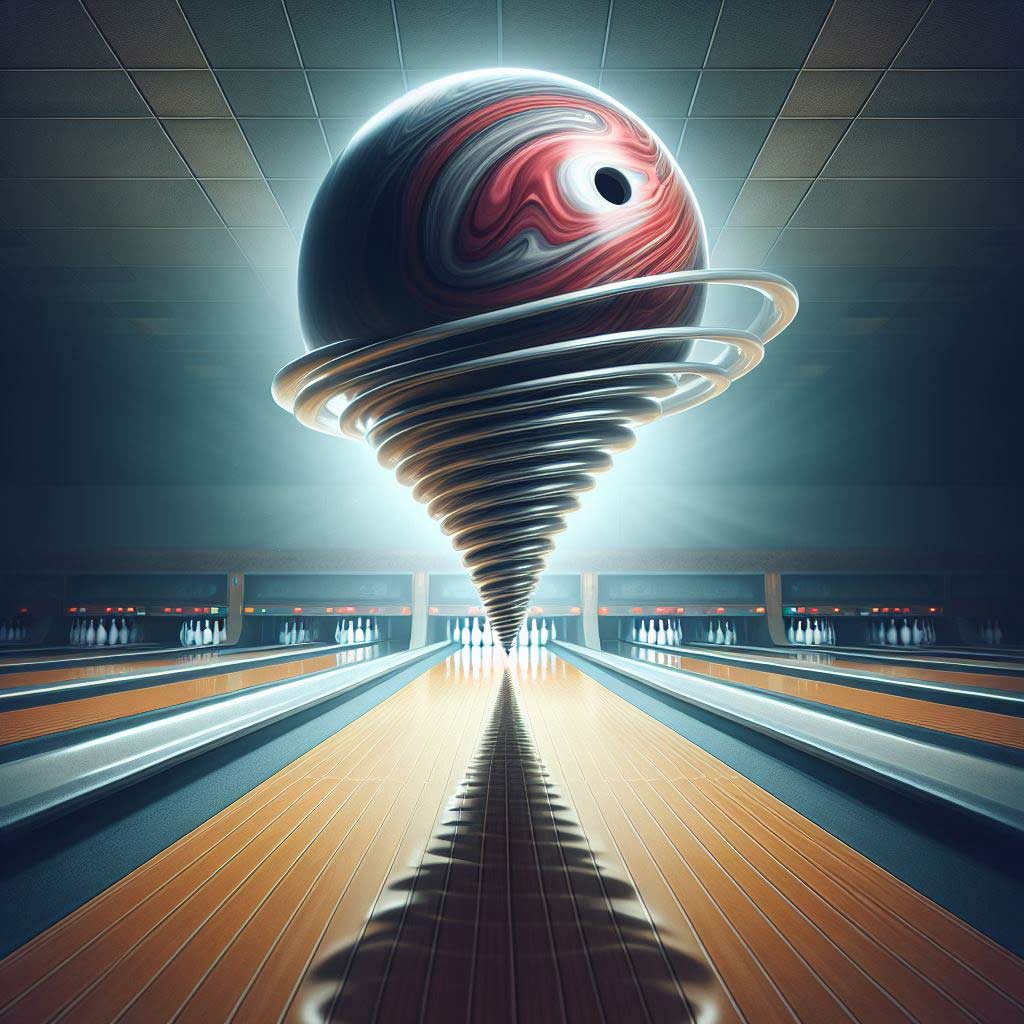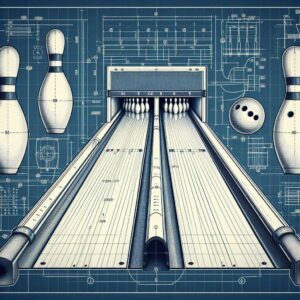Imagine this scenario – you’re at the bowling alley, winding up to take your shot. You release the ball with force, watching it careen down the lane.
But just before it reaches the pins, something unexpected happens – the ball bounces erratically, ruining your shot. Have you ever wondered, “Do bowling balls actually bounce?” It’s a curious question that gets to the heart of the physics and mechanics behind one of the world’s most popular recreational activities.
As it turns out, the behavior of bowling balls is a fascinating topic, driven by complex principles of elasticity, momentum, and the interaction between the ball and the lane surface.
Understanding this science can not only enhance your bowling experience, but also shed light on broader concepts in physics, engineering, and material science.
In this comprehensive guide, we’ll dive deep into the science behind bowling ball behavior. We’ll explore why bowling balls generally don’t bounce, the factors that can influence rebound, and how bowlers can use this knowledge to their advantage.
Whether you’re a seasoned pro or a casual bowler, this post will give you a whole new appreciation for the physics at play every time you step up to the line.
What is the Science Behind Bowling Ball Behavior?
To understand why bowling balls behave the way they do, we need to start by examining their physical properties. A standard 10-pin bowling ball weighs between 6 and 16 pounds, with the most common weight being 16 pounds. These balls are made of a variety of materials, including polyester, urethane, and reactive resin coverstocks.
At the core of a bowling ball is a dense material, often a hard plastic or ceramic, which gives the ball its impressive weight and momentum-carrying capabilities.
Surrounding this core is an outer shell or “coverstock” that provides the ball’s friction and hook potential. The specific composition of the coverstock, as well as any surface treatments, can significantly impact how the ball reacts on the lane.
The key physical property that determines a bowling ball’s behavior is its elasticity, or the ability of the material to deform under stress and then recover its original shape. This elasticity, or lack thereof, is what governs whether a bowling ball will bounce or not.
Perfectly elastic materials, like a rubber ball, are able to store and release energy efficiently, allowing them to bounce high off a surface. In contrast, bowling balls are designed to be relatively inelastic, or “dead,” meaning they absorb the majority of the impact energy rather than rebounding it.
This inelasticity is intentional, as it allows bowling balls to grip the lane surface and execute controlled hooks and turns, rather than unpredictably bouncing all over the place. The dense core material and specialized coverstock formulations work together to minimize the ball’s elasticity and rebound potential.
Do Bowling Balls Bounce on Lanes?
Given the intentional design of bowling balls to be inelastic, it’s generally true that they do not bounce on standard bowling lanes. Regulation bowling lanes are constructed with a carefully specified surface made of wood or synthetic materials that are also optimized for minimal ball rebound.
The lane surface is coated with oil, which further reduces friction and the ball’s ability to bounce. As the ball rolls down the lane, the oil helps it glide smoothly, minimizing any potential for bouncing or erratic behavior.
However, there are some edge cases where a bowling ball may appear to bounce, or at least exhibit more rebound than expected:
- Dry Lanes: If a bowling lane has insufficient oil coverage, the ball’s interaction with the drier wood or synthetic surface can result in increased friction and more noticeable bouncing. This is a common issue that bowlers must adapt to when lanes are not properly conditioned.
- Alternate Surfaces: Bowling balls may exhibit more bounce when rolling on surfaces other than a regulation lane, such as concrete, asphalt, or even certain types of flooring. These surfaces generally have higher coefficients of restitution, allowing for greater energy return and ball rebound.
- Extreme Conditions: In rare cases, such as extreme cold temperatures or other environmental factors, the materials in a bowling ball may become more elastic, leading to increased bounce. However, this is an uncommon occurrence in most bowling environments.
It’s important to note that even in these edge cases, bowling balls are still designed to minimize bouncing as much as possible. The goal is to create a controlled, predictable roll that allows bowlers to reliably execute their shots and achieve consistent results.
Factors that Affect Bowling Ball Rebound
While bowling balls are engineered to be relatively inelastic, there are several factors that can influence the degree of rebound or bounce that a ball exhibits. Understanding these factors can help bowlers better manage their ball’s behavior and optimize their performance.
Ball Weight
One of the primary determinants of a bowling ball’s rebound potential is its weight. Heavier balls, typically in the 16-pound range, tend to have less bounce compared to lighter balls in the 6-12 pound range.
The reason for this is that heavier balls carry more momentum and exert more force on the lane surface during impact. This increased force overwhelms the lane’s ability to impart a significant rebound, resulting in a more “dead” feel and reduced bounce.
Lighter balls, on the other hand, have less momentum and can sometimes experience a greater degree of rebound, especially on drier or less-oiled lane conditions. Bowlers may leverage this property by using a lighter ball when they want to intentionally increase their ball’s bounce and control its trajectory.
Ball Material
The specific composition of a bowling ball’s coverstock can also play a role in its rebound characteristics. Balls with more elastic, reactive coverstocks, such as those made of urethane or certain reactive resins, tend to have slightly more bounce compared to balls with less elastic polyester or plastic coverstocks.
The reason for this is that the more elastic coverstock materials can store and release energy more efficiently during impact, resulting in a livelier ball reaction. Conversely, the less elastic coverstocks absorb more of the impact energy, leading to a more controlled, dampened response.
Bowlers may choose balls with different coverstock materials depending on their preferences and the specific lane conditions they’re facing. A ball with a more reactive coverstock may be desirable on dry lanes, while a less reactive ball may be better suited for heavily oiled conditions.
Lane Conditions
The condition of the bowling lane itself is a critical factor in determining a ball’s rebound and overall behavior. As mentioned earlier, properly oiled and conditioned lanes are designed to minimize ball bounce and provide a predictable, controlled roll.
However, when lanes are not properly maintained or become excessively dry, the ball’s interaction with the lane surface can change dramatically. Dry lanes create more friction, which can cause the ball to bounce or skid unpredictably, making it difficult for bowlers to execute their shots accurately.
Conversely, heavily oiled lanes can sometimes result in a more lively, responsive ball reaction, as the reduced friction allows the ball to “read” the lane surface more efficiently. Bowlers must constantly adapt their ball selection and approach based on the ever-changing lane conditions to optimize their performance.
Spin and Ball Dynamics
The amount of spin and the overall dynamics of a bowling ball as it rolls down the lane can also impact its rebound and bounce characteristics.
Balls with higher levels of hook potential or dynamic imbalance may exhibit more erratic behavior, including increased bounce, when they encounter irregularities in the lane surface.
Skilled bowlers often leverage their ball’s spin and dynamic properties to achieve specific trajectories and reactions. By understanding how these factors influence a ball’s behavior, they can make informed adjustments to their ball selection, release, and approach to manage bounce and optimize their scores.
Practical Applications and Insights
Understanding the science behind bowling ball behavior doesn’t just satisfy our intellectual curiosity – it can also have practical applications that benefit bowlers of all skill levels.
Improving Bowling Performance
By understanding the factors that influence a bowling ball’s rebound and bounce, bowlers can make more informed decisions about their equipment and approach to the game. This knowledge can help them:
- Select the right ball weight and coverstock material for the lane conditions
- Adjust their release technique to manage ball dynamics and spin
- Adapt their strategy based on changes in lane oil patterns or surface conditions
- Troubleshoot and correct issues with erratic ball behavior
Optimizing Ball and Lane Maintenance
Bowling ball and lane manufacturers, as well as bowling alley operators, rely on a deep understanding of bowling ball behavior to design and maintain their equipment effectively. This knowledge helps them:
- Develop bowling ball compositions and coverstocks that optimize performance
- Implement lane conditioning and oiling protocols that create consistent, predictable playing conditions
- Diagnose and address issues with lane surfaces that may be causing undesirable ball reactions
- Educate bowlers on how to properly care for and maintain their equipment
Advancing Scientific Understanding
The study of bowling ball behavior can also contribute to broader scientific research and innovation. Principles gleaned from this domain can be applied to other areas of physics, engineering, and material science, including:
- Analyzing the dynamics of rigid body collisions and energy transfer
- Exploring the relationship between elasticity, momentum, and surface interactions
- Developing new materials and coatings with tailored friction and rebound characteristics
- Modeling complex systems involving the interplay of various physical forces
By gaining a deeper appreciation for the science behind bowling ball behavior, we can not only enhance our personal bowling experiences, but also unlock new avenues for scientific discovery and technological advancement.
Conclusion
Bowling may seem like a simple recreational activity, but the behavior of the bowling ball itself is anything but straightforward. As we’ve explored in this comprehensive guide, the physics and mechanics governing how a bowling ball interacts with the lane surface are deeply rooted in concepts of elasticity, momentum, and material science.
From understanding why bowling balls generally don’t bounce, to identifying the factors that can influence their rebound potential, this exploration has shed light on the intricate details that make bowling the captivating sport that it is.
By applying this knowledge, bowlers can make more informed equipment choices, adjust their techniques, and adapt to changing lane conditions – all in pursuit of improved performance and a greater appreciation for the game.
Beyond the bowling alley, this understanding of bowling ball behavior also has practical applications in areas like equipment design, lane maintenance, and even scientific research.
The principles at play here can contribute to advancements in materials science, engineering, and our broader understanding of the physical world.
So the next time you step up to the line, take a moment to consider the complex physics at work with every roll of the ball. Embrace the science behind bowling ball behavior, and let it enhance your enjoyment of this timeless sport.





